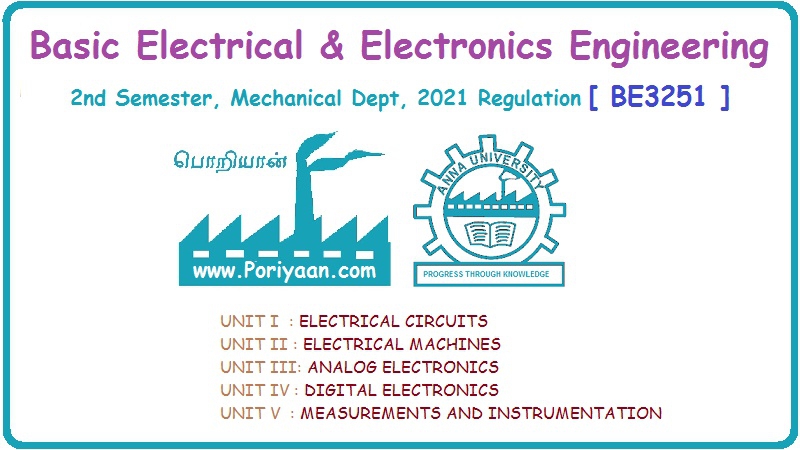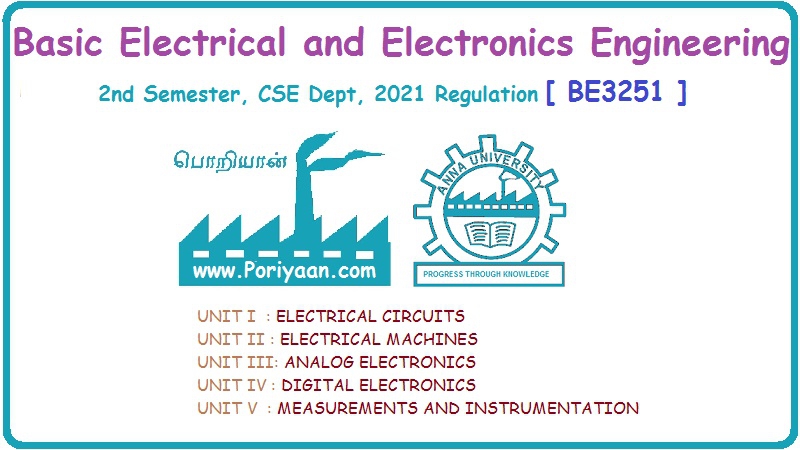Basic Electrical and Electronics Engineering: Unit I: Electrical Circuits
Power and Power Factor
Definition, Formula with Solved Example Problems | Electrical AC Circuits
Average power is the product of the effective values of both voltage and current multiplied by cosine of the phase angle between voltage and the current.
POWER
AND POWER FACTOR
Average
power:
Average
power is the product of the effective values of both voltage and current
multiplied by cosine of the phase angle between voltage and the current.
Pαν
= Veff Ieff cos Ɵ
If
we consider a purely resistive circuit the phase angle between voltage and
current is zero. Hence, the average power is
If
we consider a purely reactive circuit (ie, purely capacitive or purely
inductive), the phase angle between voltage and current is 90°. The average
power is zero, P αν = 0.
The
average power is the power dissipated in the resistive part only.
Example: 12
A voltage of V(t) = 100 sin ωt is
applied to a circuit. The current flowing through the circuit is i(t) = 15 sin
(ωt - 30°). Determine the average power delivered to the circuit.
Effective
value of the voltage Veff = 100/√2
Effective
value of current Ieff = 15/√2
Average
power = Pαν = Veff Ieff cos Ɵ
=
100/√2 × 15/√2 cos 30°
=
649.5 W
Apparent Power and
Power Factor
In
case of sinusoidal voltage applied to the circuit, the product of voltage and
current is apparent power. The apparent power is expressed in volt amperes or
VA.
Apparent
power = Veff Ieff
Power factor:
Power
factor is defined as the ratio of average power to the apparent power.
Power
factor (Pf) = cos Ɵ = Pav / Veff Ieff
In
case of sinusoidal sources the power factor is the cosine of the phase angle
between voltage and current.
Pf=
cos Ɵ
As
the phase angle between voltage and current increases the power factor
decreases. The power factor varies from 0 to 1. For purely resistive circuits,
the phase angle between voltage and current is zero, the power factor is unity.
For purely reactive circuits the phase angle between voltage and current is
90°, the power factor is zero. In a RC circuits power factor is known as
leading power factor. In an RL circuit the power factor is known as lagging
power factor.
Example: 13
A sinusoidal voltage V = 50 sin wt
is applied to a series RL circuit. The current in the circuit is given by i =
25 sin(ωt - 53). Determine (a) apparent power (b) power factor and (c) average
power.
Apparent
power = P = Veff Ieff
V
eff = Vm/√2 = 50/√2
P
= 625 VA
Power
factor = cos Ɵ
Ɵ
= 53°
cosƟ
= cos 53°
=
0.6
Average
power P αν = Veff Ieff cos Ɵ
= 625 × 0.6 = 375 W
Reactive
power.
Average
power dissipated is
Pav
= Veff Ieff cos Ɵ
From
the impedance triangle
cos
Ɵ = R/|Z|
Veff
= Ieff Z
Substitute
cosƟ and Veff in average power equator
The
above equation gives the average power dissipated in a resistive circuit.
If
we consider pure inductor,
Pr
= iVL
=
iL di/dt
i
= Im sin (ωt+0)
Pr
= Im2 sin (ωt+Ɵ) Lω cos (ωt+Ɵ) = Im2
/2 ωLsin 2 (ωt+Ɵ)
Pr
= Ieff2 ωLsin 2 (ωL+Ɵ)
Pr
= Ieff2 WL
Pr
= Ieff2 XL
where
XL = z sin Ɵ
Pr = Ieff2 z
sin Ɵ
=
(Ieff z) Ieff sin Ɵ
Pr
= Veff Ieff sin Ɵ
VAR
Power Triangle
The
power triangle is shown in fig 1.30
Average
power, Pαν = Pa cos Ɵ
Reactive
power, Pr = Pa sin Ɵ
where
Pa=
Apparent power
Example: 14
In a certain RC circuit, the true
power is 300 W and the reactive power is 1000 W what is the apparent power?
True
power, Pav = VI cos Ɵ = 300 W
Reactive
power, Pr = VI sin Ɵ = 1000 W
tan
Ɵ = 3.33
Ꮎ
= tan-1 3.33 = 73.3.
Apparent
power, Pa =
=1043.9 VA
Basic Electrical and Electronics Engineering: Unit I: Electrical Circuits : Tag: : Definition, Formula with Solved Example Problems | Electrical AC Circuits - Power and Power Factor
Related Topics
Related Subjects
Basic Electrical and Electronics Engineering
BE3251 2nd semester Mechanical Dept | 2021 Regulation | 2nd Semester Mechanical Dept 2021 Regulation
Basic Electrical and Electronics Engineering
BE3251 2nd Semester CSE Dept 2021 | Regulation | 2nd Semester CSE Dept 2021 Regulation

